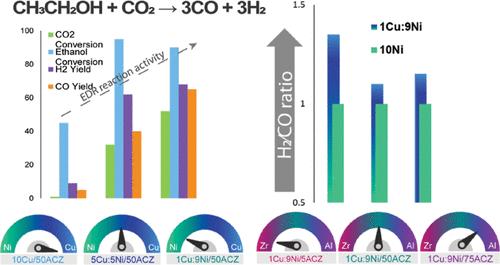当前位置:
X-MOL 学术
›
J. Phys. Chem. C
›
论文详情
Our official English website, www.x-mol.net, welcomes your
feedback! (Note: you will need to create a separate account there.)
Ethanol Dry Reforming for Hydrogen-Rich Syngas Production over Cu-Promoted Ni/Al2O3–ZrO2 Catalysts
The Journal of Physical Chemistry C ( IF 3.3 ) Pub Date : 2024-11-15 , DOI: 10.1021/acs.jpcc.4c07213 Anna Zhukova, Yuri Fionov, Sophya Semenova, Seraphim Khaibullin, Sofia Chuklina, Konstantin Maslakov, Dmitry Zhukov, Oksana Isaikina, Anton Mushtakov, Alexander Fionov
The Journal of Physical Chemistry C ( IF 3.3 ) Pub Date : 2024-11-15 , DOI: 10.1021/acs.jpcc.4c07213 Anna Zhukova, Yuri Fionov, Sophya Semenova, Seraphim Khaibullin, Sofia Chuklina, Konstantin Maslakov, Dmitry Zhukov, Oksana Isaikina, Anton Mushtakov, Alexander Fionov

|
Development of stable Ni-based catalysts with high resistance to sintering and carbon deposition is a challenge in the catalytic ethanol dry reforming (EDR) process. An effective and practical strategy is to introduce a second metal to obtain Ni-based bimetallic catalysts. In this study, bimetallic Cu–Ni nanoparticles supported on Al–Zr–Ce (ACZ) complex oxides were successfully developed as a multifunctional catalyst for syngas production via EDR and were compared with monometallic Ni and Cu catalysts supported on ACZ oxides. The addition of a small amount of copper (1%) to the catalyst resulted in the formation of a Cu–Ni alloy with crystallite sizes ranging from 10 to 30 nm, exhibiting a high metal–support interaction and resistance to sintering. However, a high Cu content limited the activity of the catalysts due to side reactions of ethanol decomposition, which led to catalyst deactivation. The catalyst 1Cu–9Ni/50ACZ exhibited the highest H2 and CO yields (78% and 70%, respectively, at T = 750 °C) at H2/CO = 1.1. The addition of Cu enhanced the H2/CO ratio by shifting the water–gas shift (WGS) reaction pathway and increasing the reducibility and dispersibility of Ni, which is attributed to the formation of a Cu–Ni alloy. The Cu–Ni alloy is active in the WGS reaction and has a synergistic effect with Ni in dehydration and dehydrogenation of ethanol, which affects the product distribution. Furthermore, copper plays a role in the reduction of carbide forms of nickel, which are precursors of graphitized coke. The support composition was also found to have a significant effect on the activity and stability of the bimetallic catalysts. It was demonstrated that the Al/Zr ratio in the support enables tuning the crystallite size of the active phase, which affects the surface concentrations of nickel and copper and their ratio and determines the ratio of reactive oxygen species that contribute to the gasification of the formed coke. This work provides a strategy to design highly selective catalysts with functional metal sites for hydrogen or syngas production with a regulated H2/CO ratio.
中文翻译:

乙醇干重整在铜促进的 Ni/Al2O3–ZrO2 催化剂上生产富氢合成气
开发具有高耐烧结性和碳沉积性的稳定镍基催化剂是催化乙醇干重整 (EDR) 工艺中的一项挑战。一种有效且实用的策略是引入第二种金属来获得镍基双金属催化剂。在这项研究中,成功开发了负载在 Al-Zr-Ce (ACZ) 复合氧化物上的双金属 Cu-Ni 纳米颗粒作为通过 EDR 生产合成气的多功能催化剂,并与负载在 ACZ 氧化物上的单金属 Ni 和 Cu 催化剂进行了比较。向催化剂中添加少量铜 (1%) 导致形成晶粒尺寸范围为 10 至 30 nm 的 Cu-Ni 合金,表现出高金属-载体相互作用和耐烧结性。然而,由于乙醇分解的副反应,高 Cu 含量限制了催化剂的活性,从而导致催化剂失活。在 H2/CO = 1.1 时,催化剂 1Cu–9Ni/50ACZ 表现出最高的 H2 和 CO 产率(在 T = 750 °C 时分别为 78% 和 70%)。Cu 的添加通过改变水-气转移 (WGS) 反应途径和增加 Ni 的还原性和分散性来提高 H2/CO 比率,这归因于 Cu-Ni 合金的形成。Cu-Ni 合金在 WGS 反应中具有活性,并且在乙醇的脱水和脱氢中与 Ni 具有协同作用,从而影响产品分布。此外,铜在还原碳化物形式的镍中发挥作用,碳化物是石墨化焦的前体。还发现负载物组合物对双金属催化剂的活性和稳定性有显着影响。 结果表明,载体中的 Al/Zr 比率可以调整活性相的晶粒尺寸,这会影响镍和铜的表面浓度及其比率,并确定导致形成焦炭气化的活性氧的比率。这项工作提供了一种策略,可以设计具有功能金属位点的高选择性催化剂,用于以调节 H2/CO 比率生产氢气或合成气。
更新日期:2024-11-16
中文翻译:

乙醇干重整在铜促进的 Ni/Al2O3–ZrO2 催化剂上生产富氢合成气
开发具有高耐烧结性和碳沉积性的稳定镍基催化剂是催化乙醇干重整 (EDR) 工艺中的一项挑战。一种有效且实用的策略是引入第二种金属来获得镍基双金属催化剂。在这项研究中,成功开发了负载在 Al-Zr-Ce (ACZ) 复合氧化物上的双金属 Cu-Ni 纳米颗粒作为通过 EDR 生产合成气的多功能催化剂,并与负载在 ACZ 氧化物上的单金属 Ni 和 Cu 催化剂进行了比较。向催化剂中添加少量铜 (1%) 导致形成晶粒尺寸范围为 10 至 30 nm 的 Cu-Ni 合金,表现出高金属-载体相互作用和耐烧结性。然而,由于乙醇分解的副反应,高 Cu 含量限制了催化剂的活性,从而导致催化剂失活。在 H2/CO = 1.1 时,催化剂 1Cu–9Ni/50ACZ 表现出最高的 H2 和 CO 产率(在 T = 750 °C 时分别为 78% 和 70%)。Cu 的添加通过改变水-气转移 (WGS) 反应途径和增加 Ni 的还原性和分散性来提高 H2/CO 比率,这归因于 Cu-Ni 合金的形成。Cu-Ni 合金在 WGS 反应中具有活性,并且在乙醇的脱水和脱氢中与 Ni 具有协同作用,从而影响产品分布。此外,铜在还原碳化物形式的镍中发挥作用,碳化物是石墨化焦的前体。还发现负载物组合物对双金属催化剂的活性和稳定性有显着影响。 结果表明,载体中的 Al/Zr 比率可以调整活性相的晶粒尺寸,这会影响镍和铜的表面浓度及其比率,并确定导致形成焦炭气化的活性氧的比率。这项工作提供了一种策略,可以设计具有功能金属位点的高选择性催化剂,用于以调节 H2/CO 比率生产氢气或合成气。


















































 京公网安备 11010802027423号
京公网安备 11010802027423号